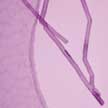Showing Spotlights 297 - 304 of 319 in category All (newest first):
 A new method based on the nanoscale Kirkendall effect was demonstrated to fabricate compound nanotubes. Through a spinel-forming solid-state reaction, high aspect-ratio core-shell ZnO-Al2O3 nanowires transform into monocrystalline ZnAl2O4 nanotubes.
A new method based on the nanoscale Kirkendall effect was demonstrated to fabricate compound nanotubes. Through a spinel-forming solid-state reaction, high aspect-ratio core-shell ZnO-Al2O3 nanowires transform into monocrystalline ZnAl2O4 nanotubes.
Jul 14th, 2006
 The mass production of nanoelectronic devices has been hampered by difficulties in aligning and integrating the millions of nanotubes required for the job. Now, researchers in South Korea have developed a method to precisely assemble and align single-walled carbon nanotubes (SWCNTs) onto solid substrates without relying on external forces such as electric or magnetic fields. This result could be an important guideline for the large-scale directed-assembly of integrated devices based on SWCNTs.
The mass production of nanoelectronic devices has been hampered by difficulties in aligning and integrating the millions of nanotubes required for the job. Now, researchers in South Korea have developed a method to precisely assemble and align single-walled carbon nanotubes (SWCNTs) onto solid substrates without relying on external forces such as electric or magnetic fields. This result could be an important guideline for the large-scale directed-assembly of integrated devices based on SWCNTs.
Jul 5th, 2006
 Carbon nanotubes have been used as nanoreactors in a simple thermal reaction process for the fabrication of high-quality, large-yield single-crystalline magnesium nitride nanowires. These nanowires are homogeneously sheathed over the entire lengths with very thin graphitic carbon tubular layers, which effectively prevent the decomposition in the presence of water in the atmosphere.
Carbon nanotubes have been used as nanoreactors in a simple thermal reaction process for the fabrication of high-quality, large-yield single-crystalline magnesium nitride nanowires. These nanowires are homogeneously sheathed over the entire lengths with very thin graphitic carbon tubular layers, which effectively prevent the decomposition in the presence of water in the atmosphere.
Jun 28th, 2006
 The ultimate internal pressure that carbon nanotubes (CNTs) can resist is only an order of magnitude below the pressure in the center of Earth. Using this high strength against internal pressure, researchers have used CNTs as pressure cells for the deformation of crystalline materials. Controlled irradiation of multiwalled CNTs can cause large pressure buildup within the nanotube cores that can plastically deform, extrude, and break solid materials that are encapsulated inside the core. Carbon nanotubes thus offer a template for use as compression/extrusion cells to study pressure-induced phase transformations and deformations of various solid nanomaterials.
The ultimate internal pressure that carbon nanotubes (CNTs) can resist is only an order of magnitude below the pressure in the center of Earth. Using this high strength against internal pressure, researchers have used CNTs as pressure cells for the deformation of crystalline materials. Controlled irradiation of multiwalled CNTs can cause large pressure buildup within the nanotube cores that can plastically deform, extrude, and break solid materials that are encapsulated inside the core. Carbon nanotubes thus offer a template for use as compression/extrusion cells to study pressure-induced phase transformations and deformations of various solid nanomaterials.
Jun 26th, 2006
 Silver single crystals were facilely synthesized on a large-scale with good reproducibility in water at room temperature in the presence of carboxyl-functionalized carbon nanotubes, without any additional reducing agent/electrochemical reducing, microwave, sonication or irradiations.
Silver single crystals were facilely synthesized on a large-scale with good reproducibility in water at room temperature in the presence of carboxyl-functionalized carbon nanotubes, without any additional reducing agent/electrochemical reducing, microwave, sonication or irradiations.
Jun 9th, 2006
 A newly developed electrostatic force directed assembly (ESFDA) technique is used to efficiently coat carbon nanotubes (CNTs) with nanoparticles. This new method advances the current technology by enabling rapid and in-situ coating of CNTs, multicomponent hybrid nanostructures, more control over the assembly process, and the possibility of tuning properties of the resulted hybrid structures.
A newly developed electrostatic force directed assembly (ESFDA) technique is used to efficiently coat carbon nanotubes (CNTs) with nanoparticles. This new method advances the current technology by enabling rapid and in-situ coating of CNTs, multicomponent hybrid nanostructures, more control over the assembly process, and the possibility of tuning properties of the resulted hybrid structures.
Jun 7th, 2006
 The extraordinary mechanical properties of carbon nanotubes (CNTs) have generated strong research interest in their possible use in reinforced composite materials. So far, different studies using carbon-nanotube reinforcements in polymer composites have reported only small improvements in the bulk mechanical properties compared with traditional fiber-reinforced composites. Through a novel approach, researchers have created a CNT-based composite material that exhibits significant improvements in fracture performance and structural damping.
The extraordinary mechanical properties of carbon nanotubes (CNTs) have generated strong research interest in their possible use in reinforced composite materials. So far, different studies using carbon-nanotube reinforcements in polymer composites have reported only small improvements in the bulk mechanical properties compared with traditional fiber-reinforced composites. Through a novel approach, researchers have created a CNT-based composite material that exhibits significant improvements in fracture performance and structural damping.
Jun 2nd, 2006
 Researchers in China are proposing a nanoelectronic switch based on telescoping double-walled carbon nanotubes (TDWCNT). By varying the overlapping length at the junction, one could control the conducting states and change it between on (high conductance state) and off (low conductance state).
Researchers in China are proposing a nanoelectronic switch based on telescoping double-walled carbon nanotubes (TDWCNT). By varying the overlapping length at the junction, one could control the conducting states and change it between on (high conductance state) and off (low conductance state).
May 26th, 2006
 A new method based on the nanoscale Kirkendall effect was demonstrated to fabricate compound nanotubes. Through a spinel-forming solid-state reaction, high aspect-ratio core-shell ZnO-Al2O3 nanowires transform into monocrystalline ZnAl2O4 nanotubes.
A new method based on the nanoscale Kirkendall effect was demonstrated to fabricate compound nanotubes. Through a spinel-forming solid-state reaction, high aspect-ratio core-shell ZnO-Al2O3 nanowires transform into monocrystalline ZnAl2O4 nanotubes.
 Subscribe to our Nanotechnology Spotlight feed
Subscribe to our Nanotechnology Spotlight feed